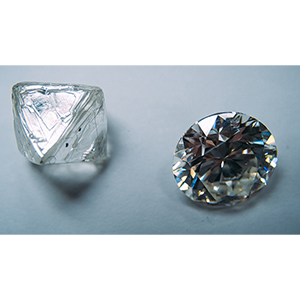
On March 1, importers bringing polished diamonds of one carat or more into the United States will need to provide “self-certification” that their diamonds aren’t from Russia.
New rules issued today by U.S. Customs and Border Protection say that qualifying diamond imports must be accompanied by a PDF document on company letterhead with one of two comments.
For nonindustrial diamonds weighing at least one carat, the document should say: “I certify that the nonindustrial diamonds in this shipment were not mined, extracted, produced, or manufactured wholly or in part in the Russian Federation, notwithstanding whether such diamonds have been substantially transformed into other products outside of the Russian Federation.”
For diamond jewelry and unsorted diamonds that meet the same weight threshold, the wording should be: “I certify that the diamond jewelry and unsorted diamonds in this shipment are not of Russian Federation origin or were not exported from the Russian Federation.”
Only one document will be required per entry.
The “self-certification” requirement is weaker than what some involved in the G7 deliberations wanted. A January statement by the U.S. embassy in Botswana said importers would need “documentary supply chain evidence” to back up any attestations.
“This is essentially a self-declaration upon import, which is what’s been happening with seafood,” says Sara Yood, deputy general counsel for the Jewelers Vigilance Committee. “I’m not sure Customs is staffed or equipped to be looking for documentary supply chain evidence for every shipment of diamonds coming into the United States.”
She adds: “I’m glad we finally have some guidance, instead of this panicked waiting that’s been happening.”
Current rules provide no guidance or exceptions for old stock or “recycled” goods that may not have mine-of-origin information. “The movement of old stones through the G7 is still an open question,” says Yood.
The G7 has said that, starting in September, the ban will apply to diamonds half a carat and over, and all stones must carry G7 certificates to be imported into member nations.
“This is basically saying that during the sunrise period [due to end Aug. 31] self-declarations are sufficient for the United States,” Yood says. “I hope people take advantage of the sunrise period to really explore the traceability programs that are out there.”
Today’s statement did say that Customs may introduce “additional filing requirements.”
“It’s possible they could do this for a month, and then they could communicate more requirements if they see that it’s necessary,” Yood says.
At press time, the other participants in the G7—including the United Kingdom, the European Union, and Canada—did not seem to have issued statements about how the March 1 ban will be enforced.
Prior to the U.S. rules being announced, De Beers put out a statement confirming its “readiness” for the new restrictions, adding that it recently signed a head of terms for a collaboration between Tracr, its diamond-tracking platform, and Sarine Technologies.
(Photo courtesy of De Beers)
Follow JCK on Instagram: @jckmagazineFollow JCK on Twitter: @jckmagazine
Follow JCK on Facebook: @jckmagazine





